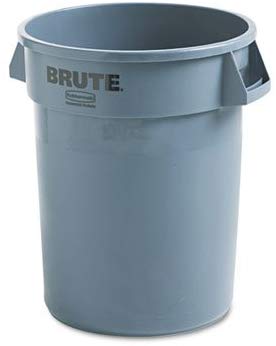Mixed saltwater can be safely stored for long periods of time but the question now becomes, what can we safely store that water in?
Many aquarists, myself included, like to store a good amount of mixed saltwater and RO/DI filtered water in case an emergency arises and we need to do multiple, large water changes.
Depending on the size of your system most people will look to store anywhere from ten gallons to several hundred gallons of each type of water.
Containers used to store mixed saltwater and Reverse Osmosis/De-Ionized (RO/DI) water for use in aquariums should be made of materials certified as Food-Grade Safe. This ensures no toxins leach from the container and into the water. HDPE containers are the most common used in the hobby.
So having a container that meets food-grade regulations sounds good, but what does it really mean? Read on to find out more…
There are multiple organizations across the globe that test and certify products to ensure they are the highest quality to be used in contact with human food. Several are explained below:
What Is The NSF?
The National Sanitation Foundation is an independent, accredited organization that tests and certifies products to ensure they meet the strictest standards to ensure public health protection.
They began in 1944 and in 1990 rebranded to NSF International to bring their accreditation to the global product market. They now have offices and laboratories all over the world.
Products certified by NSF undergo stringent tests and materials analysis to ensure they are of the highest quality to meet the standard they applied for.
NSF accreditation is not just a single application for a product, but manufacturing companies have to maintain their ongoing production processes and qualities and pass unannounced plant inspections to be able to apply the NSF Trademark to their products.
If a product fails to meet the stringent requirements, the NSF will issue a recall for that product to ensure public health protection is minimized.
When we are looking for the NSF logo it is there to certify the storage vessel material is safe to be in contact with food and water for human consumption.
Be sure to look for these symbols when looking for a water storage container:
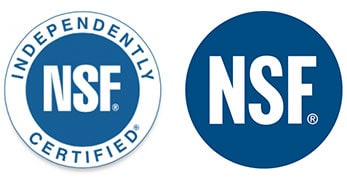
To gather more information on NSF International you can view their website by CLICKING HERE
What Is FDA Approved?
FDA is the United States Food and Drug Administration and it is a Federal agency of the United States Department of Health and Human Services.
Their role is very similar to that of NSF where they certify products that are to come into contact with human food, liquids, and ingredients. They are only responsible for the United States whereas NSF is a global certification.
Food-Grade, when issued by the FDA, means any material that is either safe for human consumption or to come into direct contact with food products.
Be sure to look for this symbol when looking for a water storage container:
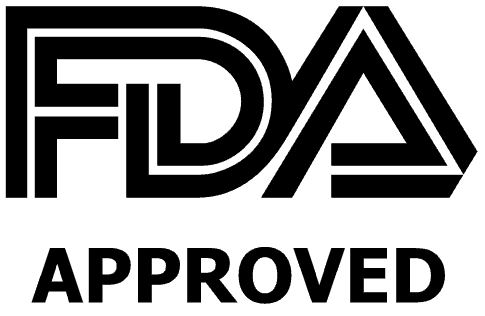
To gather more information on FDA Approvals you can view their website by CLICKING HERE
European Accreditation
For those of you situated over the pond, the main trademark to look out for the Food-Safe logo, you see below. This logo indicates the product is considered safe for food contact under the European Framework Regulation (EC) No. 1935/2004.

This is similar to the US Food and Drug Administration and helps to provide consumers with an easy way to identify Food-Safe products.
For more information on the European Framework Regulation (EC) No. 1935/2004 CLICK HERE.
Types of Plastics
In North America, there are seven categories of plastic that are used in plastic containers, vessels, wrapping, and packaging:
PET or PETE (Polyethylene Terephthalate)
This is a tough polymer that is usually clear. It has very good moisture and gas containment characteristics. It is a plastic that is mainly used for soft drinks bottles due to its gas containing capability.
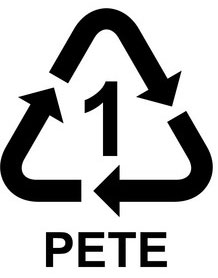
HDPE (High-Density Polyethylene)
This is a very popular polymer used in most storage containers due to its chemical resistance properties. It is also another strong polymer which makes it ideal for molding into tough containers just like the ones we use to store our saltwater in!

Vinyl or PVC (Polyvinyl Chloride)
Vinyl is one of the most versatile polymers because it has so many excellent properties. It can be made thin and clear to make food wrapping, it can be extruded to make frames for windows and doors, but the way that most aquarists use PVC is for flexible and rigid piping.

LDPE (Low-Density Polyethylene)
Another versatile polymer because of is tough, yet flexible characteristics. This type of plastic is mainly used for squeezy bottles, garbage bags, and milk cartons.
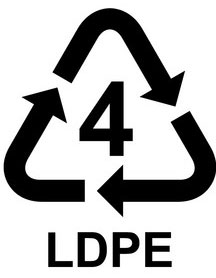
PP (Polypropylene)
This is a high-strength polymer with very good resistance to hot and cold temperatures. It is mainly used to manufacture lids and caps and products that can be heated or chilled. Most Tupperware and Rubbermaid food storage containers are made from this type of plastic.

PS (Polystyrene)
The main property of this polymer is it is very good an insulation. It is usually found in the foam or expanded polystyrene that is used to manufacture drinks cups, packing peanuts and food trays.

OTHER
This symbol is usually found when there is a mixture of polymers used to make the product. This type of plastic is usually unable to be recycled.
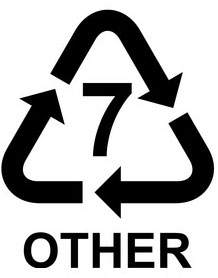
This is an excerpt from the American Plastics Council website that explains how to use a specific kind of plastic well:
“Copper, silver, and aluminum are all metals, yet each has unique properties. You wouldn’t make a car out of silver or a beer can out of copper because the properties of these metals are not chemically or physically able to create the most effective final product. Likewise, while plastics are all related, each resin has attributes that make it best suited to a particular application. Plastics make this possible because as a material family they are so versatile.”
The main type of plastic used to manufacture the containers we wish to use for storing our saltwater is HDPE. The strong, chemical resistant and easy molding capabilities of this type of plastic are perfect for Food-Safe Grade storage containers.
When you find a container made from HDPE with any of the following logos your water will be safe:




Recommended Saltwater Storage Containers
There are two main types of container frequently used throughout the saltwater hobby. These have been the proven ‘Go-To’ storage containers for years because they are relatively inexpensive, come in a range of sizes, are chemically resistant and are readily available. You can find the two recommended product ranges here:
Rubbermaid Brute Trash Can Series:
These have been the most popular storage container for aquarists for years. They are fairly inexpensive, easy to acquire and are NSF Certified.
Excerpt for Rubbermaid Brute Trash cans from the NSF Website:
ROUND BRUTE® CONTAINERS, LIDS & DOLLY[20] [21] [22]
Container
10 Gal. Brute
20 Gal. Brute
32 Gal. Brute
44 Gal. Brute
55 Gal. Brute
Lid
10 Gal. Brute Lid
20 Gal. Brute Lid
32 Gal. Brute Lid
44 Gal. Brute Lid
55 Gal. Brute Lid
The production date is shown on each model. Models produced after January 1, 1999 are NSF Certified.
CLICK HERE To View The NSF Webpage
CLICK HERE To View the Rubbermaid Brute Webpage
You can view a great selection of Rubbermaid Brute containers HERE at Amazon.com
Norwesco Above Ground Containers
In recent years these types of water container has been gaining popularity due to their compact size. Norwesco manufactures many shapes and sizes to fit your space, need and budget. These too are also NSF Certified.
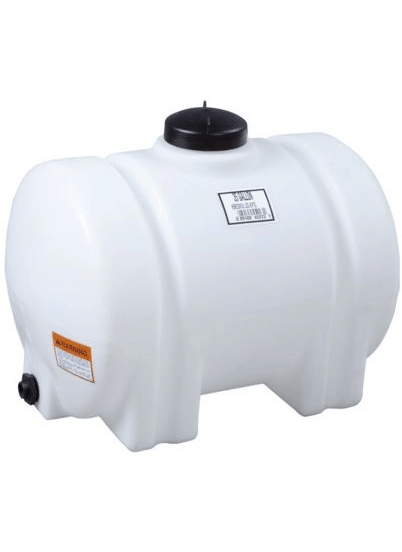
Excerpt from the Norwesco Website:
“Are your tanks FDA approved and is it safe to store water in an above-ground tank?”
“Yes, it is safe to store water in the Norwesco above ground tanks and below ground cistern tanks shown on our website. The resin used to manufacture these tanks meets FDA specifications for safe storage of potable water. Click on the following link for specific information regarding the FDA status of the resin.“
“Are your above-ground tanks NSF certified?”
“NSF International, founded in 1944 as the National Sanitation Foundation, is known for the development of standards, product testing, and certification services in the areas of public health, safety and protection of the environment. Norwesco was the first polyethylene tank producer to receive the NSF61 certification, where applicable, for our potable water tanks.
The NSF61 certification process is done on a plant by plant basis. We currently have tanks that are NSF61 certified in five of our manufacturing facilities: Fairfield TX, Hanford CA, Tooele UT, Washougal WA & Lancaster OH. Click on the following link for information regarding the NSF61 status certification for the five facilities listed above. NSF certification.”
You can view a great selection of Norwesco Storage containers HERE at Amazon.com
Types of Plastics To Avoid
Not everyone may have the budget or the availability of the Brute or Norwesco storage containers so other alternatives may have to be sought. By looking for the trademarks above on the storage containers you wish to purchase you should be OK.
Here are some examples that will probably not be Food-Safe. You will need to check the labels carefully:
- HDPE Plastic Containers Without One of the Logos Above
- 5 Gallon Utility Buckets from Hardware Stores
- Garbage Cans or Pails
- General Purpose Buckets
- Pet Food Buckets
- Any container— that has been used to store chemicals previously, even if it is Food-Safe Grade
To Finish
By selecting a container with any one of the Trade-Mark logos above you will be guaranteed a product that will safely store your fresh and saltwater and not leach any toxins into it.
By keeping the container closed with a lid you will prevent evaporation, causing your salinity to increase and prevent the ingestion of dirt, debris, bacteria, and toxins from your home entering the water and potentially allowing it to spoil.
Having a Ready-To-Go supply of both freshwater and mixed saltwater could save your aquarium one day! It did for me.
Further Reading
You may find the following articles interesting and help your research and knowledge:

